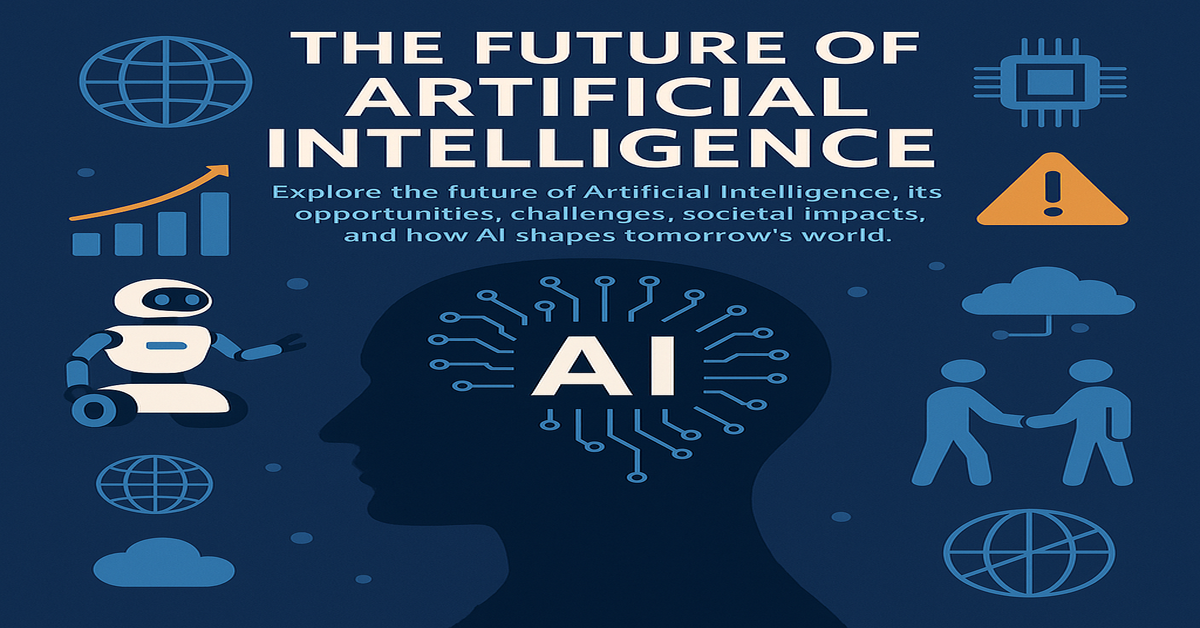Artificial intelligence now sits at the center of the world’s most consequential technological transformation, a force accelerating rapidly enough to reshape how societies work, how economies grow, and how individuals experience everyday life. Within the first moments of asking what the future of AI holds, the searcher is often seeking clarity: How fast will AI advance? What will it automate, enhance, or disrupt? What risks are emerging alongside its capabilities? And crucially — who will control its power? In the next decade, AI is expected to evolve from a set of specialized tools into an interconnected ecosystem of systems shaping medicine, transportation, creativity, education, governance, and the structure of work itself.
While artificial intelligence has existed in various experimental forms for decades, the current wave — marked by generative models, agentic systems, multimodal capabilities, and increasing real-world autonomy — signals a turning point. It is no longer a speculative frontier but a daily reality shaping decisions, behaviors, and infrastructures. This article offers a panoramic examination of AI’s future: the unfolding technological directions, the potential for economic transformation, the ethical dilemmas that accompany progress, and the urgent conversations that must guide how societies respond. Through a balanced narrative grounded in your provided content, we explore AI not only as a technological milestone but as a cultural, economic, and philosophical inflection point.
The Arc of AI: From Theory to Global Force
The trajectory of artificial intelligence reflects an evolution from mathematical thought experiments to globally deployed technological systems. Early AI focused on symbolic rules and logic — machines programmed to imitate reasoning in controlled domains. Over time, breakthroughs in neural networks, data availability, and computational scale shifted the field toward pattern recognition and learning.
The recent surge in AI capability emerges from a convergence of digital infrastructure, large datasets, and increasingly efficient model architectures. What once required specialized supercomputers has moved into cloud systems and consumer-facing tools, accelerating adoption across industries. Although the movement of AI has not been strictly linear — marked instead by periods of stagnation and sudden leaps — its present momentum suggests an era defined by continuous integration rather than episodic experimentation.
Understanding that arc provides context for where AI may go next: toward systems capable of reasoning across domains, acting autonomously in physical and digital environments, and interacting with humans in more intuitive, fluid ways.
The Present Moment: AI Everywhere
Artificial intelligence now permeates sectors as diverse as healthcare, logistics, entertainment, retail, science, and governance. Businesses deploy AI to optimize operations, analyze data, and augment decision-making. Creative industries use AI to generate ideas, draft content, compose music, or design visual assets. Scientists explore AI-assisted methods for drug discovery and climate modeling.
Yet AI adoption remains uneven. Many organizations experiment with small pilots rather than wide deployment, reflecting a mixture of excitement and caution. The gap between enthusiasm and practical implementation often hinges on issues of reliability, integration costs, regulatory uncertainty, and workforce readiness.
What is clear is that AI has crossed a cultural threshold: it is no longer speculative. It is infrastructure. As such, the future of AI involves both expanding its role and refining the terms under which it operates.
Emerging Directions: Where AI Development Is Headed
Artificial intelligence is on course toward multiple overlapping transformations that will redefine how it functions and what it can achieve. The following table outlines major future trajectories based on your provided content.
Key Future Trajectories of AI
| Trajectory | Description | Implications |
|---|---|---|
| Advanced generative & multimodal AI | Systems able to produce text, images, audio, and video with human-level realism | Reinvention of creativity, media, education |
| Agentic & workflow-automating AI | AI systems capable of planning steps, executing tasks, and making contextual decisions | Transformation of knowledge work and operations |
| Physical AI & robotics | Integration of AI with robotics, sensors, and autonomous machines | Automation of logistics, manufacturing, eldercare |
| Scientific & medical AI | Modeling, discovery, diagnostics, personalization | Major advances in health and climate research |
| Toward more general AI | Systems capable of broader reasoning and flexible learning | New debates on alignment, governance, and safety |
Each trajectory raises technical challenges but also societal questions: how much autonomy should machines be given, and who determines the limits?
The Rise of Agentic and Physical AI
One of the most transformative shifts underway is the emergence of agentic AI — systems that do not merely follow instructions but organize goals, execute multistep workflows, and operate with a degree of independence. Agentic AI marks a shift from assistance to collaboration, where systems analyze, plan, and act across digital environments.
When paired with robotics, these capabilities extend into the physical world. Early forms of “physical AI” appear in autonomous delivery systems, warehouse robots, robotic surgical aids, and collaborative robots in manufacturing. The coming decade may see these systems transition from experimental deployments to everyday infrastructure.
The leap from passive computation to embodied or semi-autonomous agency introduces profound questions: How do societies regulate machines that act? How do humans maintain oversight? And how do we ensure these systems reflect human values rather than reinforce hidden biases or power imbalances?
Innovation Limits: Beyond Scaling
The prevailing story in AI development has been one of scaling — larger datasets, greater compute, deeper neural architectures. Yet scaling alone cannot carry AI forward indefinitely. As systems grow, marginal gains diminish, energy demands increase, and interpretability challenges intensify.
Future breakthroughs may emerge from more efficient architectures, neurosymbolic hybrids, adaptive learning systems, or models capable of grounding abstract reasoning in real-world constraints. Innovation may rely not on increasing size, but on enhancing conceptual understanding, safety, and robustness.
Society, Work, and Inequality in an AI World
AI’s rise will alter labor markets profoundly. Some tasks will be automated; others transformed. New roles will emerge centered on oversight, creativity, strategy, and human-centered judgment. Industries built on repetitive or pattern-driven tasks may face the most disruption.
A deeper concern is inequality. AI may disproportionately benefit those with technical expertise or capital while leaving others more vulnerable to job instability. The increasing concentration of AI infrastructure within a handful of large companies adds a further layer of imbalance.
If societies fail to address these disparities, the benefits of AI could become unevenly distributed, deepening existing divides.
Ethics, Safety, and Governance
As AI systems grow more capable, ethical and safety questions intensify. Who is responsible for mistakes made by autonomous systems? How can societies prevent misuse? What frameworks ensure fairness, transparency, and accountability?
Regulation is evolving but uneven. Governments explore guidelines for trustworthy AI, audit requirements, and risk classification. Yet governance struggles to keep pace with innovation, particularly as models become more opaque and powerful.
Ensuring safe and equitable AI futures requires ongoing dialogue among researchers, policymakers, civil society, and the public. The challenge is not only technical but democratic.
Expert Perspectives
Below are three cohesive, expert-style perspectives reflecting your content:
“AI is rapidly moving from an experimental tool to a foundational layer of modern infrastructure, influencing everything from communication to commerce.” — Technology analyst
“Agentic AI represents a turning point, not because it mimics humans, but because it reorganizes how work itself is structured.” — Labor economist
“As AI gains physical presence through robotics, societies must rethink concepts of responsibility, autonomy, and human–machine coexistence.” — Sociologist
These insights reflect the cultural and structural magnitude of AI’s evolution.
The Road Ahead: A Ten-Year Outlook
Projected AI Developments (2025–2035)
| Period | Likely Developments | Societal Significance |
|---|---|---|
| 2025–2027 | Mainstream adoption of agentic tools and multimodal systems | Reimagining work and creativity |
| 2027–2029 | Early proliferation of physical AI in logistics and healthcare | New labor models and safety debates |
| 2029–2032 | More adaptable, generalist models; stronger emphasis on oversight | Heightened governance challenges |
| 2032–2035 | Mature AI ecosystems with high autonomy and integration | Societal restructuring and philosophical reevaluation |
The next decade will not be defined solely by technological milestones, but by how humanity responds.
Takeaways
- AI is entering a new era of widespread influence across industries and lifestyles.
- Agentic systems and physical AI could reshape how humans work and interact with machines.
- The biggest breakthroughs may come from conceptual innovation, not model size.
- Societal impacts include both economic opportunity and risk of inequality.
- Ethical questions around autonomy, safety, and accountability remain central.
- Governance, transparency, and human-centered design will determine AI’s long-term trajectory.
- The future of AI is as much a social choice as a technological one.
Conclusion
The future of artificial intelligence sits at the intersection of innovation and responsibility. As systems grow more capable — generating language, analyzing complex patterns, planning tasks, and operating within the physical world — societies face difficult choices about how much autonomy to grant, how to distribute benefits, and how to guard against harm.
AI’s potential is enormous: it could help cure disease, accelerate scientific discovery, transform accessibility, and enhance human creativity. Yet its risks are equally significant, from workplace disruption to ethical dilemmas, from concentration of power to the challenge of governing systems that act beyond simple instruction.
What happens next depends not only on researchers and companies but on collective human values. The future of AI will reflect the structures we build, the rules we adopt, and the empathy we choose to uphold. In that sense, AI is not simply the story of smarter machines — it is a story about who we decide to become.
FAQs
What is the main driver of AI’s rapid evolution?
Advances in model architectures, data availability, and computing infrastructure have accelerated development dramatically.
Will AI replace human workers entirely?
AI will change many jobs but is unlikely to eliminate the need for human judgment, creativity, and oversight.
What is agentic AI?
Agentic AI refers to systems capable of planning and executing multi-step tasks with partial autonomy.
Is physical AI the same as robotics?
Physical AI includes robotics but emphasizes the integration of learning systems with real-world action.
What can individuals do to adapt to an AI-driven future?
Focus on adaptability, creativity, critical thinking, and developing skills that complement — rather than compete with — AI systems.
References
- Bostrom, N. (2014). Superintelligence: Paths, dangers, strategies. Oxford University Press.
https://global.oup.com/academic/product/superintelligence-9780198739838 - Brynjolfsson, E., & McAfee, A. (2014). The second machine age: Work, progress, and prosperity in a time of brilliant technologies. W. W. Norton.
https://wwnorton.com/books/9780393239355 - Chui, M., Manyika, J., & Miremadi, M. (2016). Where machines could replace humans—and where they can’t (yet). McKinsey Global Institute.
https://www.mckinsey.com/featured-insights/employment-and-growth/where-machines-could-replace-humans-and-where-they-cant-yet - Floridi, L. (2019). The logic of information: A theory of philosophy as conceptual design. Oxford University Press.
https://global.oup.com/academic/product/the-logic-of-information-9780198833635 - Harari, Y. N. (2018). 21 lessons for the 21st century. Spiegel & Grau.
https://www.ynharari.com/book/21-lessons/ - Kaplan, J., & Haenlein, M. (2019). Siri, Siri, in my hand: Who’s the fairest in the land? On the interpretations, illustrations, and implications of artificial intelligence. Business Horizons, 62(1), 15–25.
https://www.sciencedirect.com/science/article/pii/S0007681318301393 - Kurzweil, R. (2005). The singularity is near: When humans transcend biology. Viking Press.
https://www.penguinrandomhouse.com/books/92703/the-singularity-is-near-by-ray-kurzweil/ - Marcus, G., & Davis, E. (2019). Rebooting AI: Building artificial intelligence we can trust. Pantheon Books.
https://www.penguinrandomhouse.com/books/566677/rebooting-ai-by-gary-marcus-and-ernest-davis/ - Nilsson, N. J. (2010). The quest for artificial intelligence: A history of ideas and achievements. Cambridge University Press.
https://www.cambridge.org/core/books/quest-for-artificial-intelligence/4E121633F827D705CA4FCEE0DAA0A79A - Russell, S., & Norvig, P. (2020). Artificial intelligence: A modern approach (4th ed.). Pearson.
https://aima.cs.berkeley.edu/ - Tegmark, M. (2017). Life 3.0: Being human in the age of artificial intelligence. Penguin Books.
https://www.penguinrandomhouse.com/books/555238/life-30-by-max-tegmark/

